Beth Tabler's Blog, page 194
March 28, 2022
Review – Travels in the Dark by Jordan Loyal Short
TRAVELS IN THE DARK by Jordan Loyal Short is the third and final novel in the Dreadbound Ode. The Dreadbound Ode is a fascinating mix of space opera, dark fantasy, and politics that reminds me strongly of Warhammer 40K. It is a dark and somber world where an oppressive empire beats down the Medieval-like impoverished worlds in it sphere of influence. Worse, the Underworld is a literal place and it is full of dead gods as well as regret.
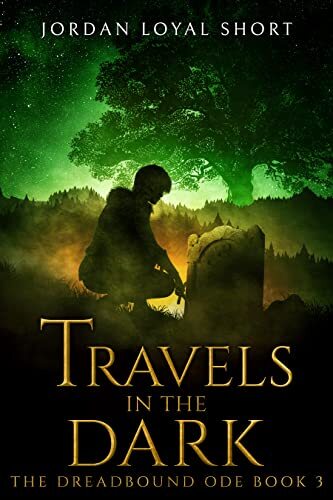 The premise is that our protagonists have really been screwed up by the events of the previous novel. Lyssa is dying of the injuries she sustained trying to finish off the pirates who enslaved her people, Henrik has managed to free himself from slavery but made countless enemies in the process, and Brohr is now totally insane with necromantic powers that are linked to forces darker than can be imagined.
The premise is that our protagonists have really been screwed up by the events of the previous novel. Lyssa is dying of the injuries she sustained trying to finish off the pirates who enslaved her people, Henrik has managed to free himself from slavery but made countless enemies in the process, and Brohr is now totally insane with necromantic powers that are linked to forces darker than can be imagined.
After two relatively grounded and low fantasy science fiction stories, this book amps up the sorcery and supernatural significantly. The Dead Gods are escaping their prison and unleashing the forces of the insane spirits of the Underworld. The sole remaining “good” god (which is a very questionable statement) is manifest but clearly outmatched by the powers arrayed against him. Brohr is also outright using necromancy to raise the dead in hopes of being able to unite with Lyssa.
I think my favorite part of the book is the extended quest in the Underworld by Lyssa to try to get out of it. The Underworld is a place filled with people tormented by their regrets and inability to move on past their deaths. Given the number of people Lyssa killed on her way to getting trapped there, there’s more than a few people who want to pay her back whether or not it is going to endanger everyone.
Things go from bad to worse for our protagonists as they find themselves crippled not only by the impressive forces arrayed against them but also their own horrible personality flaws. Brohr’s obsession with Lyssa is the only thing keeping him going, which drives him to increasingly horrific acts. He’s also the only person who can protect the remaining survivors. Henrik is the Prophet but that is a power that means very little among the power-hungry atheists who head the religion as well as Inquisition.
If I had any complaints about the book, it’s the fact I was really enjoying the low fantasy and politically charged world of the previous books. There’s not much room for political subtlety or moral ambiguity when the entirety of the universe is at stake. I could have read more stories about slavers, pirates, and corruption among the Electors before dark gods. This is a small complaint, though.
There are a lot of twists and turns in this book with all the major plotlines resolved by the end. The characters go through hell, literally, and is all the more interesting. The grand finale is both a satisfying end as well enjoyable story in its own right. It is definitely within the dark fantasy/grimdark genre. Flawed characters, unspeakable horrors, and a bittersweet ending that shows the consequences of our characters’ actions.
Check Out Travels in the Dark
The post Review – Travels in the Dark by Jordan Loyal Short appeared first on BEFOREWEGOBLOG.
March 27, 2022
The Books That Made Us – Fear and Loathing in Las Vegas: A Savage Journey to the Heart of the American Dream by Hunter S. Thompson
I was on a page somewhere just after Barstow when my love for FEAR AND LOATHING IN LAS VEGAS took hold. That love was deep and immediate and while I may have seen the film umpteen times before I read the book, it was the reading of Hunter S. Thompson’s incredible work of gonzo journalism that truly bonded it to my writing DNA. The nature of reality can be a tricky business. We use various fleshy bits to sense and send evidence of an external reality to our brain, only for it to choose what all that input might mean and paint its best guess on our consciousness. That’s sketchy on a good day, but add a few chemicals to the mix and…
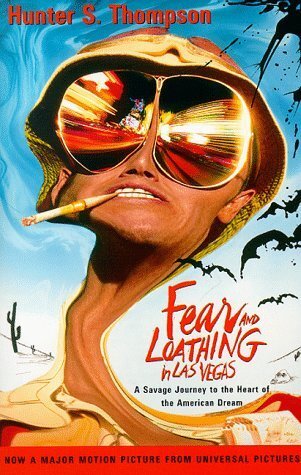 What FEAR AND LOATHING IN LAS VEGAS does remarkably well is to show that, while reality is skewed and twi@jrushingwritessted by whatever intoxicant of the moment happens to be coursing through Raoul Duke’s veins, it’s still portrayed as his reality. Not some other realm. Not some chemical dream. It’s his lived experience. His poor, drug-soaked brain is still trying to do its job. It’s taking in those dulled sensory clues and attempting to sort them with altered, perverted logic. What it paints on his consciousness is just as “real” as his normal, everyday reality, it’s just been filtered through booze and drugs and adrenalin.
What FEAR AND LOATHING IN LAS VEGAS does remarkably well is to show that, while reality is skewed and twi@jrushingwritessted by whatever intoxicant of the moment happens to be coursing through Raoul Duke’s veins, it’s still portrayed as his reality. Not some other realm. Not some chemical dream. It’s his lived experience. His poor, drug-soaked brain is still trying to do its job. It’s taking in those dulled sensory clues and attempting to sort them with altered, perverted logic. What it paints on his consciousness is just as “real” as his normal, everyday reality, it’s just been filtered through booze and drugs and adrenalin.
While I may not have been able to relate to the kaleidoscope reality within the book personally, as I read, I was living those experiences alongside the character and I bought it hook line and sinker. I never felt the need to question the reality Duke was living, even though I knew there was a “real” world outside the one his drug-bound mind was creating for him. All of his experiences, chemical or not, counted as Duke’s reality because it just was the reality he was living. His reality was valid even if what he was experiencing was far-fetched and unsound. This was the key lesson for me from Fear and Loathing in Las Vegas. All reality is constructed… from whatever our gray matter is given to work with. All reality is valid, even if it’s not always sound, and that, I think, can apply to the characters and worlds within our own books. When a conclusion follows logically from its premises, it’s valid. Even if the premises we start with are totally false. For instance in the book, There is a hotel front desk agent talking to Raoul Duke She is a moray eel.
Therefore, front desk agents can be moray eels. That’s ridiculous but hey, that’s what Duke’s brain was making him see. For an argument to be valid and sound, it has to start with premises that are actually true. A magazine needs a journalist to cover the Mint 400. Duke was hired to cover the mint 400. Therefore he’s working as a journalist. Everything checks out. While all reality is subjective, our day-to-day, unaltered perceptions are functionally accepted as true. It’s the best we can do. But, add some mescaline pulled from the trunk of a car, and any soundness in thinking gets carried off by bats. However, even though Duke’s perceptions are growing false as the drugs kick in, his lived reality is still valid. His brain is taking what it can get as premises for reality(This is bat country!) and making conclusions based on those false premises. That bats are real to Duke, even when they’re not. His fear of those bats is real even though there’s nothing to fear. The bats aren’t sound because they don’t exist, but they’re valid because he’s experiencing them and making decisions based on them.
While the soundness may come and go, FEAR AND LOATHING IN LAS VEGAS is written as one solid, valid reality that incorporates being both sober and blasted. Focusing on validity makes questioning the smaller, individual details of the story a bit pointless. We, as readers, either buy this reality or we don’t and if we buy it, we can just settle in for the ride. Our story vetting is over. That’s a comfortable spot. As writers, when we treat validity as what counts in feelings of realness, both for our writing and for readers, our fantasy worlds, heinous hells, and sci-fi future scapes become more alive and easier for readers to accept. In FEAR AND LOATHING IN LAS VEGAS, both the sound and unsound world exist within the story but I think this focus on validity works just as well using our own reality, outside the book, as the sound world.
Remember, these are the worlds our characters live in. These are their realities, even if they aren’t “sound” compared to our own. That’s okay. There’s still a logic involved. Their brains are still sorting info and making decisions based on their experiences of their world. In RADIO, I used this lesson as gospel. The main character, Marduk, lives and operates in a world in which gods are semi-immortal mind control artists. He’s one of them so that goes without question. That reality is valid and within the workings of the story, also sound.
He’s proof. He, too, spends a lot of time inside other people’s minds. That internal reality is also valid and sound. He’s actively doing it. It’s coming from true premises within the story. However, he also spends a lot of time being very, very high on opium. But, again, it’s his experiences and his “real” reality, despite the outer world of the story being his “sound” reality. The euphoria he feels is valid. And while all of the above is unsound compared to our real world, treating it as a valid reality, writing it as a valid reality, helps the reader experience it as a valid reality. My personal goal as a writer isn’t to simply immerse my readers in a pretend world with pretend characters. That can be fun but it’s just not my jam.
My goal is to immerse them into real-feeling moments in a real-feeling character’s life. Into the life they’re living in the world in which they exist. Even if that moment or world is totally fantastical. Even if that character is a many thousands of years old fake god with mind control powers. The hope is that if I can maintain validity for my world and characters, then the reader doesn’t have to do the work of “buying” what’s going on as the story progresses. They can just relax and live in the world along with the characters. It’s how a kid from the sticks could sidle up to a Las Vegas bar between Raoul Duke and a lizard woman and just go with the flow.
I was asked to accept that this was really what this character was experiencing and because every bizarro moment in FEAR AND LOATHING IN LAS VEGAS was presented as valid, I did.
Check out Fear and Loathing in Las Vegas: A Savage Journey to the Heart of the American Dream by Hunter S. ThompsonAbout the Author J · Rushing is an American writer whose work blends elements of adventure, fantasy, science fiction, and horror to create worlds that feel as familiar as they do foreign.
J · Rushing is an American writer whose work blends elements of adventure, fantasy, science fiction, and horror to create worlds that feel as familiar as they do foreign.
He is a musician, amateur luthier, and former teacher who first traded the microbreweries and Cascade Mountains of the Pacific Northwest for the bustle and beauty of Paris. After nearly three years in the City of Light he and his wife settled near Zürich, Switzerland where they spend much of their time traveling and immersing themselves in the outdoors.
Websitehttps://jrushingwrites.com/TwitterjrushingwritesThe post The Books That Made Us – Fear and Loathing in Las Vegas: A Savage Journey to the Heart of the American Dream by Hunter S. Thompson appeared first on BEFOREWEGOBLOG.
March 26, 2022
Review – Blade Runner 2019, Vol. 1: Los Angeles by Michael Green, Mike Johnson, Andres Guinaldo
From the Rain-Soaked Future of Greater Los Angeles
BLADE RUNNER 2019 VOLUME ONE: LOS ANGELES is a graphic novel set in the world of Ridely Scott’s BLADE RUNNER. Wow, imagine that. I’ve always been a little leery of tie-in fiction because it’s rarely done well. Very often, it’s just a cash grab and the stories told are irrelevant to the larger narrative. But this book changed my mind.
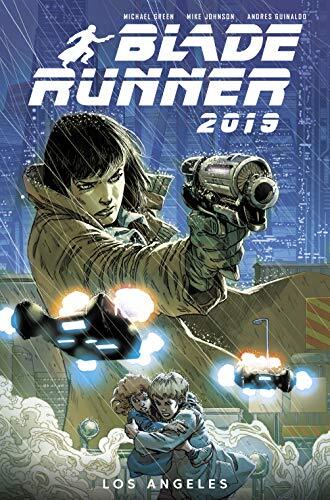 You see, I absolutely love Blade Runner and think of it as one of the defining works of science fiction let alone cyberpunk. I even would go so far as to say it’s an improvement over Do Androids Dream of Electric Sheep. Blasphemy, I know. I’m going to state that Blade Runner 2019 blew my expectations away.
You see, I absolutely love Blade Runner and think of it as one of the defining works of science fiction let alone cyberpunk. I even would go so far as to say it’s an improvement over Do Androids Dream of Electric Sheep. Blasphemy, I know. I’m going to state that Blade Runner 2019 blew my expectations away.
Part of what makes the book work is the fact it doesn’t attempt to tell the story of Deckard and Rachel or any other existing canon character. Instead, it focuses on Ash, a South Asian American Blade Runner who is only able to function due to an artificial spine. Ash hates Replicants and sells their body parts after retiring them. Having grown up in the worst sort of environment, she vents her frustration on those who she believes are toys of the rich.
Irony abounds as one of the remaining Earth oligarchs hires her to track down his missing daughter. Ash wants nothing to do with the super-rich but finds her superiors aren’t giving her a choice. It doesn’t help that the case (initially) doesn’t have anything to do with Replicants. From there, we get a delightfully Chinatown-esque mystery that involves a terrified mother, Replicants, and parental kidnapping.
The art is a major reason this book is fantastic and Ash is a beautifully designed character. However, the entire Blade Runner world in all its post-environmental collapse glory is a sight to behold. While I question why any uninhabited tropical island can exist on this place and not be full of the wealthy, I otherwise have no complaints about this work. The action is crisp but the art is particularly beautiful in bringing to life the hellish world of technology gone amuck alongside wretched hives.
Ash is a fantastic protagonist and successfully invokes all the film noir tropes that made the original Blade Runner work so well, but updated for the 21st century (in both senses of the word). She has a lot of interesting character development over the course of the first volume but also doesn’t make any dramatic changes. Her interactions with Replicants are colored by her own bigotries but she’s also aware that they might be the lesser evil in the long run compared to the super-rich.
Check Out Blade Runner 2019The post Review – Blade Runner 2019, Vol. 1: Los Angeles by Michael Green, Mike Johnson, Andres Guinaldo appeared first on BEFOREWEGOBLOG.
Review – Gloomhaven the Board and Video Game
Before we talk about Gloomhaven the video game, we need to talk about Gloomhaven the board game. The board game is, frankly, not designed for casual play. This is good news to the hardcore game fanatic, who will delight in the complicated map pieces, the rule-laden cards, and a seemingly endless sea of little cardboard tokens. The game has an unapologetically harsh difficulty curve, and if you want to see everything the game has to offer you’re going to need to get pretty good at the tactics of the game.
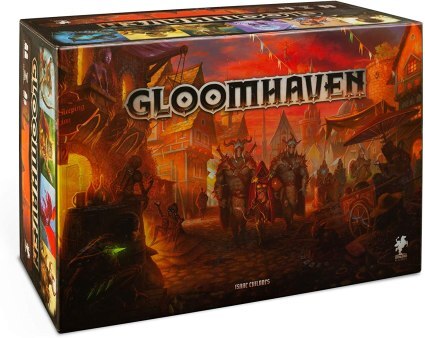 The good news about the video game is that the computer handles all of the fiddly bits for you. The game plays more smoothly (and much more quickly) when the computer is keeping track of everything for you. There are, however, a few flies in this ointment. My main complaint is that in its effort to streamline the gameplay, it actually obscures some important game mechanics. For example, there is are two decks of cards for Events, and once each Event is resolved, the card is either placed at the bottom of the deck (to be played again later) or is removed from the game entirely. In the board game version, this provides important context as to the nature of the Event; in the video game, players are simply not informed what happens to the Event card. There are many similar experiences that are by their nature obvious while playing the board game, and completely opaque in the digital game.The story told by the game is fairly solid. I don’t know that I’d sit down and read the novelization if one is ever written, but there’s certainly enough going on to keep players interested and motivated to continue. There are light-hearted moments and plenty of comedy beats, but the overall feeling of the story is… well, gloomy. A good rule of thumb is that a happy character in Gloomhaven is very likely either getting ready to incite some violence, or is unwittingly on the precipice of disaster. Not always, of course, but very, very frequently.
The good news about the video game is that the computer handles all of the fiddly bits for you. The game plays more smoothly (and much more quickly) when the computer is keeping track of everything for you. There are, however, a few flies in this ointment. My main complaint is that in its effort to streamline the gameplay, it actually obscures some important game mechanics. For example, there is are two decks of cards for Events, and once each Event is resolved, the card is either placed at the bottom of the deck (to be played again later) or is removed from the game entirely. In the board game version, this provides important context as to the nature of the Event; in the video game, players are simply not informed what happens to the Event card. There are many similar experiences that are by their nature obvious while playing the board game, and completely opaque in the digital game.The story told by the game is fairly solid. I don’t know that I’d sit down and read the novelization if one is ever written, but there’s certainly enough going on to keep players interested and motivated to continue. There are light-hearted moments and plenty of comedy beats, but the overall feeling of the story is… well, gloomy. A good rule of thumb is that a happy character in Gloomhaven is very likely either getting ready to incite some violence, or is unwittingly on the precipice of disaster. Not always, of course, but very, very frequently.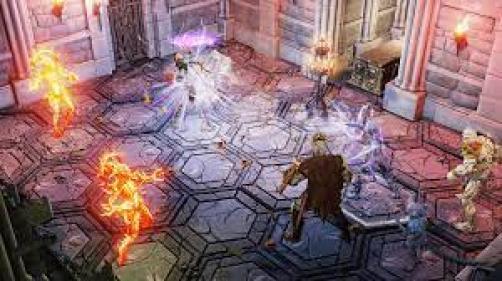 Overall, I feel like Gloomhaven the video game is a sort of ersatz version of the board game. It’s entertaining, and also quick and convenient – but perhaps Gloomhaven was never meant to be quick or convenient. It certainly loses something in the translation. If you’re looking for the full Gloomhaven experience, I’d recommend the board game. If you enjoy the board game but want to skip the token-fiddling, or want to play with a friend online, then the digital edition of the game might be just what you need. Otherwise, I have to say that you can find games with equally good tactical elements, better story, better presentation, and better performance for half the price.Value: 3 / 15Story: 12 / 15Gameplay / Mechanics: 10 / 15Presentation: 4./ 15Fun: 32 / 40Add 15 points if you’re a fan of the board gameAdd 10 points if you’ve got a deep tactical itch that needs scratchingOverall score out of 100:: 61 – 86For reference:Value: how well does the game reward your investment of both dollars and time?Story: Would you watch a video of someone else playing this game just for the sake of the story?Gameplay / Mechanics: If this game were only abstract tokens and numbers, how much fun would it be?Presentation: How pleasant is this game to interact with?Fun: Sometimes, a game is more (or less) than the sum of its parts; the most important thing is whether it was an enjoyable experience.Check Out Gloomhaven
Overall, I feel like Gloomhaven the video game is a sort of ersatz version of the board game. It’s entertaining, and also quick and convenient – but perhaps Gloomhaven was never meant to be quick or convenient. It certainly loses something in the translation. If you’re looking for the full Gloomhaven experience, I’d recommend the board game. If you enjoy the board game but want to skip the token-fiddling, or want to play with a friend online, then the digital edition of the game might be just what you need. Otherwise, I have to say that you can find games with equally good tactical elements, better story, better presentation, and better performance for half the price.Value: 3 / 15Story: 12 / 15Gameplay / Mechanics: 10 / 15Presentation: 4./ 15Fun: 32 / 40Add 15 points if you’re a fan of the board gameAdd 10 points if you’ve got a deep tactical itch that needs scratchingOverall score out of 100:: 61 – 86For reference:Value: how well does the game reward your investment of both dollars and time?Story: Would you watch a video of someone else playing this game just for the sake of the story?Gameplay / Mechanics: If this game were only abstract tokens and numbers, how much fun would it be?Presentation: How pleasant is this game to interact with?Fun: Sometimes, a game is more (or less) than the sum of its parts; the most important thing is whether it was an enjoyable experience.Check Out GloomhavenThe post Review – Gloomhaven the Board and Video Game appeared first on BEFOREWEGOBLOG.
March 25, 2022
SIX ELEMENTALS AUTHOR INTERVIEW – MICHELE QUIRKE
 Six Elementals Author Interviews will introduce prospective readers to some of the best writers in their genre you may, or may not, have heard of, via a series of six questions. I encourage you to check out the work of these phenomenal creatives! Links to their websites and purchase links will always appear, accompanying the interview. Check them out!
Six Elementals Author Interviews will introduce prospective readers to some of the best writers in their genre you may, or may not, have heard of, via a series of six questions. I encourage you to check out the work of these phenomenal creatives! Links to their websites and purchase links will always appear, accompanying the interview. Check them out!
I am very humbled to be joined by the fantastic Michele Quirke, author of historical fantasy. Michele’s current published work is: The Fires of Treason.
 P.L.: Thank you so much Michele for joining Six Elemental Interviews! I loved The Fires of Treason! Can you please tell readers of this interview what your awesome book is about?
P.L.: Thank you so much Michele for joining Six Elemental Interviews! I loved The Fires of Treason! Can you please tell readers of this interview what your awesome book is about?
Michele: Princess Elizabeth has always idolized and supported her older brother, but when Greg is accused of treason and banished, her loyalty to him is tested in ways she never could’ve imagined. As she leaves her luxurious lifestyle behind to join him in exile, she must learn to cope with the everyday struggles of the working class, all while keeping her true identity a secret. Facing new hardships and the looming threat of execution, Elizabeth will need to toughen up if she has any chance of surviving outside the palace walls.
Prince Gregory spent his entire life trying to prove himself worthy of the crown until his banishment releases him of all the pressures and obligations that have chained him down. Although he has no intention of raising an army to defend his birthright, he soon learns that not everyone is content to let him walk away from the throne. With his sister’s safety and well-being to consider, Gregory must make a decision that will change both their lives forever.
P.L.: Oh, that synopsis would definitely make me want to buy the book, which of course, I did! Who are some authors that have influenced your writing style?
Michele: In all honesty, I’m not quite sure if any authors have influenced my actual writing style. I sort of just write what I feel and haven’t given much thought to where the influence come from. That said, there is one author who has always inspired me. Jodi Jensen is my critique partner and basically the person who encouraged me to believe in myself and my work. I never would’ve published if not for her. She taught me so much and I am forever grateful that she was in my corner when I needed that push to pursue my dream of being a writer.
P.L.: Jodi sounds fantastic! It’s obvious she has a positive impact on you and your writing. You are a popular and well-respected self-published author. Your book is of exceptionally high quality in all facets: writing, editing, cover design. There still remains a perception in some circles that self-published books are of a lesser quality than traditionally published. Do you have any comments about that?
Michele: Truth be told, I was of that mindset a few years ago. However, once I joined Twitter and actually started reading more indie and self-published books, I learned just how wrong I was. There are so many incredible indie books out there. I suppose I feel pity for people who think this way because they are going to miss out on some truly amazing stories if they only read books that have been traditionally published.
P.L.: You are so right! The bulk of my own TBR is self-published work now, because I completely agree with you, so many amazing self-published books out there! Your novel, The Fires of Treason, is impeccably researched, and the setting feels like a real European kingdom. How much research was involved in writing your book?
Michele: I probably spent more time researching than writing. Although The Fires of Treason takes place in a fictional kingdom, it’s based on Elizabethan England. Therefore, I tried to keep everything as accurate for that time period as possible. One of my favorite resources was A Compendium of Common Knowledge 1558-1603 by Maggie Secara. It was super helpful!
P.L.: That sounds like an excellent resource! What inspired you to write The Fires of Treason?
Michele: This might be a little strange, but it was heavily inspired by Avatar: The Last Airbender . Prince Zuko and Prince Gregory (one of my protagonists) have a lot in common. Both have power-hungry older sisters, both have callous fathers, and both were banished. At the time, I was also watching The Tudors . So The Fires of Treason started off as a little nod to both shows, then quickly evolved into its own thing.
P.L.: Wow, I must admit I did not see Avatar: The Last Airbender coming, but in reflection I can see the similarities between Zuko and Gregory! And I loved The Tudors! That I can totally see in terms of comparisons to your book! Great stuff! Do you have any advice for aspiring writers?
Michele: Honestly? Just write. Enjoy yourself. The rest will come with time.
P.L.: Wise counsel! It’s been fantastic to speak to you, Michele! Thanks for being interviewed!
Check out the original interview here
Buy The Fires of Treason on Amazon here
Follow Michele Quirke on Twitter @MicheleQuirke

The post SIX ELEMENTALS AUTHOR INTERVIEW – MICHELE QUIRKE appeared first on BEFOREWEGOBLOG.
March 24, 2022
SIX ELEMENTALS AUTHOR INTERVIEW WITH T.L. COUGHLIN
 Six Elementals Author Interviews will introduce prospective readers to some of the best writers in their genre you may, or may not, have heard of, via a series of six questions. I encourage you to check out the work of these phenomenal creatives! Links to their websites and purchase links will always appear, accompanying the interview. Check them out!
Six Elementals Author Interviews will introduce prospective readers to some of the best writers in their genre you may, or may not, have heard of, via a series of six questions. I encourage you to check out the work of these phenomenal creatives! Links to their websites and purchase links will always appear, accompanying the interview. Check them out!
 I am very honoured to be joined by the best-selling YA fantasy author, T.L. Coughlin! T.L’s current published work is: Of Us and Them.
I am very honoured to be joined by the best-selling YA fantasy author, T.L. Coughlin! T.L’s current published work is: Of Us and Them.
P.L.: This is an incredible treat for me T.L. to be able to interview you! Thank you so much for joining Six Elementals Interviews! Congratulations on your recent debut novel, Of Us and Them! And kudos at having signed a publishing deal with Darkstroke Books! It has been quite the successful past few months for you! Can you tell us about how you became a published author, and what the process of publication was like with Darkstroke?
T.L.: I started my querying journey less than a year ago. I’ve been writing ever since I was young, but never thought much of it, creating stories for my little sister for bedtime and submitting creative writing for school. Finally, when you-know-what happened, I finally had time to find my passion. From there, and after speaking with you, I was fully invigorated with inspiration! I wrote my novel in a few months, edited it countless times, had my beta readers look it over and then I was off to the querying trenches!
It was a tumultuous journey, filled with lots of self-discovery and of course, imposter’s syndrome. I received many agent rejections saying they loved my writing and that it was a great premise, but that they couldn’t quite figure out where to put it in the market. I was honestly so close to shelving the project to wait until it would be “less niche”, but then I came across a small publisher who focuses on literature of the darker nature.
Within a few months of submitting to them, I received a full request and shortly after an offer of publication! OF US AND THEM had finally found its perfect home! From there, it’s been a whirlwind of edits, cover design preparation (they are wonderful when it comes to a truly collaborative process) and now my book is set for publication in November!
P.L.: I am so glad you persevered and published your book!! Kudos to your determination and hard work! We readers are all happier for it! I absolutely loved reading Of Us and Them! It was such a great book! For those readers who have not yet read your exciting novel, can you please tell us what it’s about?
T.L.: Thank you so much! I am thrilled you enjoyed it. OF US AND THEM is a Young Adult science fiction novel with historical fantasy and a murder mystery. You follow seventeen-year-old Evren who was born for a sole purpose: to serve as a vessel for the Leviathans, a saviour alien species hidden in global dragon lore. She longs to join the secret society who concealed them in history and as the last of the twelve prophesied Paladins, she needs to. With the world in ruin, their unification will signal the Leviathans’ return to Earth to protect humans from their worst enemy: themselves.
But Evren’s ambitions are dashed when a Paladin is found dead. The murder sets her world ablaze and now she must stop the saboteur or risk destroying a celestial plan millennia in the making. However, finding the truth—and the killer—in a society built on deceit won’t be easy, especially with Evren’s fierce and guarded mother as its leader.
OF US AND THEM features reinterpretations of global dragon mythology, a formidable multiracial cast of teenagers, saviour aliens, and a high-stakes whodunit all set in the Canadian Rocky Mountains.
P.L.: It was a special significance for me, as another Canadian author, to see one of the settings for your book in such a beautiful part of our country! I truly believe all writers are motivated by reading some of their favourite authors. Who are your greatest writing influences? Which authors inspired you to write?
T.L.: My greatest writing influences are Anne McCaffrey and Marissa Meyer. They seem a bit on opposite ends, but this is where I draw most of my inspiration from. Anne McCaffrey is an epic world-builder that sets her characters off on adventures of self-discovery and high-stakes, not to mention she first had dragons as an alien species!
With Marissa Meyer, the way she writes young adult fiction is perfection and makes it incredibly relatable to the younger audience. The freshness and joviality, while also touching on more serious coming-of-age elements makes for a wonderful reading experience.
My favourite author, by far, though is Piers Anthony, an incredibly prolific writer who brings humour (and puns!) into everything he writes. I have been reading his Xanth Series since I was in my young teens and am entirely obsessed! I wish I could say I have his quick wit in my writing, but truly…it’s incomparable!
P.L.: Those are some fantastic authors you mention! I must say, I did find some wonderful little nuggets of humour too, in Of Us and Them, that made me chuckle. Moreover, your novel has some fantastic historical elements woven into its tapestry! Can you tell us about some of the research that you needed to complete to bring these elements to your work?
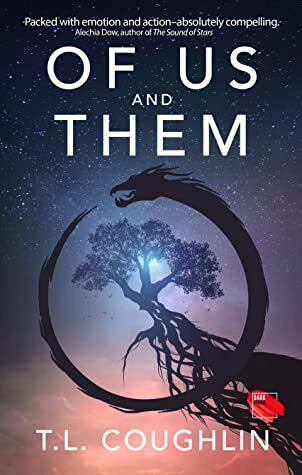 T.L.: Oh wow, I can’t even begin to describe how much research I did. The majority of my research was on dragon mythology that’s found throughout many cultures across the globe. I went into the common tales, but also ventured into the different interpretations and minor stories to ensure I was gaining the full view. It was an incredible experience because there were so many elements, as I was researching, that connected themselves!
T.L.: Oh wow, I can’t even begin to describe how much research I did. The majority of my research was on dragon mythology that’s found throughout many cultures across the globe. I went into the common tales, but also ventured into the different interpretations and minor stories to ensure I was gaining the full view. It was an incredible experience because there were so many elements, as I was researching, that connected themselves!
History truly wrote it for me, I just simply found the gold nuggets throughout and brought them into one book. I also researched heavily into the names of my characters. Each Paladin is a multiracial young adult who is from a mix of cultural background; however, there is one that they most identify with. From there, their weapons and their names were written to reflect that!
P.L.: I can attest having read your novel that all diligence in your research paid off! You have also been very successful at some of the marketing aspects of independent authorship including having your own merchandise! And boy does that swag look fantastic! Do you have any tips for your fellow authors about how to thrive in self-promotion?
T.L.: Thank you! I am a bit of a fan myself. The big tips would be, do your research, talk to other authors, and don’t be afraid to ask for guidance! (There’s no sense reinventing the wheel twice!) I searched through social media and various merchandise creators to see what type of promotions and marketing options were out there and then chose which suited my “brand” the best!
Also, don’t forget about buying the rights to images if you use them! I ended up doing a combination between purchasing an Adobe Stock extended licence that allows merchandising, and also created my own art! A huge element for me as well was having great friends like you, P. L., and the Darkstroke Author community. A lot of my resources were from these incredible networks!
P.L.: You have also been a huge inspiration for me and such a valuable resource and source of information and advice! Thank you so much! Co-incidentally, you are also now one of my favourite YA fantasy authors! Who are some of your favorite YA authors today?
T.L.: Goodness, always a hard question to narrow to a few. Currently, it would be Alechia Dow, author of The Sound of Stars (who I was lucky enough to get a cover endorsement from), Marissa Meyer, Neal Shusterman, Holly Black and Tracy Deonn!
P.L.: Again, some amazing choices! Holly Black in particular is an author whose books are on my TBR and I am really looking forward to reading them. Thank you so much. T.L., for joining me on Six Elementals Interviews! It was wonderful chatting with you!
The original interview is here
Buy Of Us and Them here Connect With The Author

E-mail: t.l.coughlin@outlook.com
Website: www.tlcoughlin.com
Twitter: @TL_Coughlin
Instagram: @TL_Coughlin
Facebook: TL Coughlin and T. L. Coughlin- Author Page
E-Book Preorder: http://mybook.to/ofusandthem
The post SIX ELEMENTALS AUTHOR INTERVIEW WITH T.L. COUGHLIN appeared first on BEFOREWEGOBLOG.
#SPFBO7 Review – The Mortal Blade by Christopher Mitchell
The Mortal Blade is a solid fantasy story; one that readers who love military and political fantasy, as well as stories with huge winged lizards will enjoy. And if you like books where the gods walk among us then this should be right up your alley too. The Mortal Blade won’t hit you in the feels, it won’t rock your foundations, but it will give you hours of enjoyment when you need a good read to settle into.
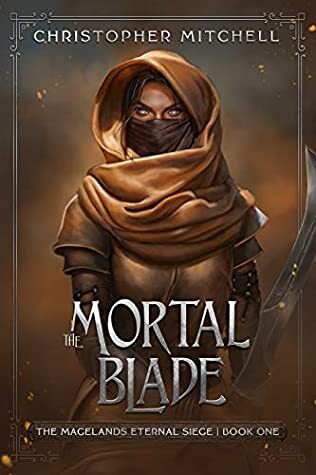 The narrative starts off strong with an opening scene filled with deception and close-cut action. It was a great way to begin the book and felt like the opening to a movie. I thought it was really well done and was a great intro to one of the main characters and some of her special abilities. That first chapter hooked me and did it’s job of establishing my expectations for what would follow.
The narrative starts off strong with an opening scene filled with deception and close-cut action. It was a great way to begin the book and felt like the opening to a movie. I thought it was really well done and was a great intro to one of the main characters and some of her special abilities. That first chapter hooked me and did it’s job of establishing my expectations for what would follow.
Christopher Mitchell’s writing, from beginning to end was solid and the pacing was very even. I never felt like there was a long slog in the middle, or that it dropped off at the end. Quite the opposite really. Each chapter was paced well with narrative tension and action building toward a climax and then settling in for the start of the next. I never felt bored and my mind never wandered with this read. Mitchell’s writing was as good as his pacing. I can’t remember a single instance of stumbling over a weird turn of phrase or word choice; the dialogue was on point; and while the prose wasn’t purple or flowery, for this kind of book it isn’t meant to be. I don’t want to call it journeyman because that implies a slight insult, but it just worked as needed. Like I said, it was just solid from start to finish.
I also thoroughly enjoyed the characters. The blurb for the book only mentions two which is a little disappointing because there are two more primary POV characters (Aila and Daniel) who add significantly to the story, one of whom was a favorite. And there’s one non-pov “character” who adds some very important flavor and drama to the story who I found myself looking forward to reading about more and more as the chapters flew by. Each character is varied in skills, abilities, and background and pushes the plot along in their own unique ways. I can see where some readers may be annoyed by Daniel, the young lieutenant in the city guard (for reasons I won’t get into here), but I liked his character development. I don’t necessarily like him but I did like what he brings to the book in terms of conflict and drama within the larger story. I also think he’ll be more important in future books. At first I thought Corthie was way overpowered, but as time went on those feelings were assuaged as more of the history and worldbuilding was brought to the fore. Aila was something of a badass (like Corthie) and has some awesome abilities, and she brings a good bit of conflict and drama to the plot as well. Maddie was fun and had that rebellious snarky quality I enjoy in characters. But the characters are where my first quibble’s with the book are found. What I said about Corthie being a little OP still has a negative side. He’s waiting for his sister to arrive to rescue him, but in reality he doesn’t need her. It seemed he could rescue himself without any help from anyone else if he wanted to, and that makes me wonder if the plot could have or should have gone in a slightly different direction earlier than it did. Then there’s the love story that develops between a couple of the characters. I’m not opposed to love stories at all, but this one was just a bit far-fetched in terms of how quickly it happened, and the dynamics between the characters. I won’t give it away here, but when you read it I’m sure you’ll understand what I’m talking about. The love story just didn’t work for me and unfortunately, it does help to drive part of the plot later in the book. It wasn’t enough of an issue for me to become frustrated with the story, but I did shake my head at it.
The worldbuilding in The Mortal Blade was something I enjoyed but at the same time it also warred with my suspension of disbelief. The entire story happens within the confines of a single large city. And it seems that the entirety of humanity exists within this one city. Every year on a seasonal cycle the greenskins (seems like orcs…maybe not) appear outside the walls and lay siege to the city, and every year the soldiers on the walls fight them off. It’s a pretty cool concept and leaves a lot of mystery about what else is in the world and how big it is. But that’s also where things began to give me pause. There’s a LOT of people in this city. It’s pretty huge. How do they sustain themselves? How do they grow enough food within the walls; how do they have enough wood for fires to heat and cook; how do they get enough water; how do they get enough materials to make things if there’s no one else to trade with? Now, there does seem to be some connection to perhaps another world outside of this one but it isn’t really explored much. I kept getting hung up on this point and eventually I just told myself to ignore it and enjoy the book, which I did, but these questions always lurked in the background.
What I enjoyed most however is what you’d hope to enjoy most with a book. The story. I dug it. A family of gods and demi-gods who rule a city in person. A city made up of have’s and have nots, the nobility, the poor, the soldiers, and the criminals. Only this family of gods is VERY dysfunctional. They’ve already undergone one civil war centuries ago and now a new one threatens. The city is something of a powder keg looking for a spark. Add the threat from without to the rising threats from within and well…you’ve got an interesting story on your hands.
The Mortal Blade is the first installment of The Magelands Eternal Siege series of which, at the time I read it, there were six more books! This isn’t the first Magelands story, however. There are two more series, The Magelands Origins, and The Magelands Epic. I didn’t at any time feel like I needed to have read the other series to appreciate or follow along with this one. There were a few instances where I might have understood a little more of the backstory had I read them, but it wasn’t necessary.
I do hope you’ll give this book a look. I enjoyed it and I think most of you will too. I definitely plan to check out more of the stories in this universe.
Rating: 7.0
Check Out The Mortal Blade as Well As The Full SeriesThe post #SPFBO7 Review – The Mortal Blade by Christopher Mitchell appeared first on BEFOREWEGOBLOG.
March 23, 2022
Review – Baldur’s Gate
Everyone has a book, movie, or video game that has a special place in their hearts. The actual medium doesn’t matter but the story or characters tantalized you enough that you wanted to experience more. These were our gateway drugs and are things that both tantalize the imagination as well as enspell the spirit. In this case, I’m going to tell you about a game called Baldur’s Gate.
Baldur’s Gate wasn’t my introduction to fantasy or even Dungeons and Dragons but it was something that, nevertheless, kept pulling me back into the world despite the fact it was more or less an “alpha” version of what Bioware would eventually achieve with their far more polished Dragon Age setting. I’m going to discuss the plot of each game in-depth so if you care about spoilers for a twenty-year-old game, I recommend you go buy the Enhanced Edition for PC or console then come back in about a hundred hours.
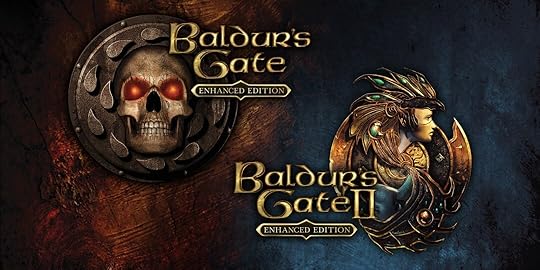 Baldur’s Gate (1998)
Baldur’s Gate (1998)The premise was you were a convenient orphan who was raised in the library-castle of Candlekeep. You could be a man, woman, elf, human, or whatever that was any number of professions. Freedom was maximized even if your story would probably indicate you would have been learning either how to fight or how to shoot fireballs in the version of Faerun’s Library of Congress.
Unfortunately, for Gary (as I named my protagonist), he has the problem of being a Chosen One. Not Chosen for anything good like the Dragonborn of Skyrim or Nezzarine. No, he is the child of Bhaal the God of Murder. Bhaal has been dead, a rare status for a god, for decades but his evil essence was passed down to all of his mortal descendants.
This is part of a complicated plot to resurrect himself as the surviving Bhaalspawn will kill each other off like immortals in Highlander. The survivors will grow stronger from each person they kill as well as each Bhaalspawn, justifying D&D experience, and eventually the last will become the new God of Murder.
The Highlander influences are actually pretty thick as your opponent is Saverok, your half-brother who is basically the Kurgan. They should have gotten Clancy Brown to do the voice instead of Kevin Michael Richardson (no shade on Trigon and Goro, though). Saverok is smarter than the Kurgan, though, as he’s doing a complicated plot to start a war where he’s supplying both sides with weapons as well as corrupting the iron ore so he has a monopoly on steel. It’s not your typical fantasy villain stuff and while you thwart him, I have to say he’s actually one of the smarter bad guys in gaming.
Part of what I like about is that it’s only from level 1-10 that you play. Most games go much-much higher. Yet you’re fighting Kobolds, Gnolls, skeletons, and giant centipedes rather than liches as well as other horrors. You can build a party from a couple of dozen NPCs, many of whom don’t get along at all, and while they don’t have much to say–some leave a big impression. For example, I will always love Imoen and refuse to accept she’s my half-sister when my character was fully in love with her.
No Kentucky jokes. Only we can do that.
 Siege of Dragonspear (2016)
Siege of Dragonspear (2016)I think it says just about everything you need to know about how Baldur’s Gate touched so many lives that they eventually released an expansion for the first game ten years later. Specifically, eight years after the sequel was done. It’s common enough to do a prequel to games but how often do you have an interquel? That requires a level of fan dedication and love that the developers believe exists to know all the characters as well as their complicated weird plots.
The Siege of Dragonspear is designed to bridge the gap between Baldur’s Gate and Baldur’s Gate 2: Shadow of Amn where the protagonist goes from being on top of the world to a hated outcast despite saving the world (or at least Sword Coast) from Saverok. You do, indeed, start off as living in the Ducal Palace of Baldur’s Gate, beloved by all (though my in-game reputation was absolute crap due to killing a few hundred guards), and spending time with his beloved sister Imoen.
Unfortunately, the reward for a job well done is to do it all over again and Gary is called upon to slay the Joan of Arc-like figure leading a crusade across the Sword Coast. No one is entirely sure WHY the woman is leading a crusade, but her followers are looting and pillaging in the name of all the gods. Which, given this is the Forgotten Realms, is ridiculous. The gods hate each other. So you have to get the band back together in order to lead an army to slay her and disperse her rebellious forces.
With ten years of game technology advances, the game looks visually spectacular while remaining an isometric top-down RPG. The dialogue also gets to take advantage of the fact that we know where all the characters will end up. The game is heavy on foreshadowing and contains one of the last performances by the amazing David Warner (AKA Batman: The Animated series’ Ra’s Al Ghul and Jon Irenicus). The protagonist’s dialogue options also get a lot “sillier” options, which implies the events of the first game have driven them to become a snarky bastard.
A sense of doom hangs over the expansion and the funny thing is that it makes the story much-much better, which shouldn’t be possible for two such classic games. The fusion isn’t always one hundred percent perfect but it’s close enough. In the end, no matter what you do, someone good is going to get hurt as well as the line between good and evil being blurred.
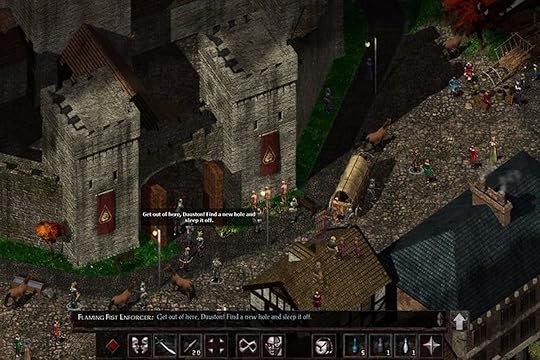 Baldur’s Gate II: Shadows of Amn
(2000)
Baldur’s Gate II: Shadows of Amn
(2000)The sequel to Baldur’s Gate is one of those stories that manages to improve on the original with a stronger plot, stronger characterization, darker tone, and motherfricking David Warner. The protagonist has found himself kidnapped by a mad wizard, tortured, experimented on, and stripped of their soul.
David Warner’s Jon Irencius is really what makes this module. An exiled elvish archwizard, he is possessed of a complex and interesting backstory that would give a George R.R. Martin protagonist pause. The protagonist isn’t left behind, though, as his relationships with his various associates are allowed to grow considerably. Baldur’s Gate II is where the option to have romances with his or her companions arrived. While some of them were undercooked, especially for female protagonists, others like Viconia have become iconic characters.
If there’s any flaws in the game, it is the fact that the story of the protagonist being the scion of Bhaal takes a backseat to its new villain. This is corrected heavily in the Throne of Bhaal expansion but, briefly, it feels like it is the Irenicus show instead of dealing with the fact you’re the child of an evil god. Which is a rare sentence. The deaths of the beginning of long-time party members Khalid and Dynaheir also added a sense of gravitas that players who didn’t let their party members meet the final death might have missed. Plus, you get to explore the Underdark and that’s always a plus.
It has little to do with Bhaal’s resurrection but is one of the best of Bioware’s stories even today.
Baldur’s Gate II: Throne of Baal (2001)Every journey must come to an end and the Throne of Bhaal is where it reaches its climax. Civilization is under assault by the last of the Bhaalspawn aside from you. The remainder of them have decided to team up in order to make sure there can be only one, sort of like the bad Tributes in The Hunger Games.
The Throne of Bhaal brings back the plot of your (un)holy heritage full force and the possibility of resisting becoming a monster or embracing that energy to become a god. It is a genuinely epic quest and one that suffers a bit for the fact that the bosses are somewhat one note compared to Saverok and Irenicus.
The Throne of Bhaal pulls out all the stops and you can effectively slay a god in its final levels or actually do slay a god (or the Lord of the Abyss) with the Demogorgon as a bonus boss. It also has a set of ending slides that manage to incorporate a wide variety of default states depending on your decisions as well as companions.
In the end, it is a suitable climax for what was a truly epic adventure until this point. The Baldur’s Gate franchise would continue after Throne of Bhaal as well with some books (that were absolutely awful–no offense to the author), comic books (which I adore), as well as an upcoming sequel with Baldur’s Gate III. The Enhanced Editions would also come out, making all of the games into a single epic adventure with improved graphics as well as game assets.
You can even play it on console.
The post Review – Baldur’s Gate appeared first on BEFOREWEGOBLOG.
March 22, 2022
Interview with Author Jacob Sannox

“Onetime,” insists the pikeman in Colonel Hawkins Regiment of Foote, owner and ruler of Fort Sannox. “Might piss off my mates.” I suggest that when one is an author reality is optional, but the onetime pikeman insists, and despite what you might have read a pike is mightier than a pen. Especially since I don’t even have a pen, only a laptop, where Sannox clearly has experience with all sorts of weaponry. Traveling through sixteen centuries requires precautions.
 When I first read The Ravenmaster’s Revenge, the first book in Jacob Sannox’s The Return of King Arthur series, I felt as if I just came off a rollercoaster that rode recklessly through history and genres, somehow ending exactly where it should have. I bought the sequel, Agravain’s Escape, thinking that now I knew what was coming. I was wrong – apparently, the first book was only a warm-up. What’s more rollercoaster-like than a rollercoaster?
When I first read The Ravenmaster’s Revenge, the first book in Jacob Sannox’s The Return of King Arthur series, I felt as if I just came off a rollercoaster that rode recklessly through history and genres, somehow ending exactly where it should have. I bought the sequel, Agravain’s Escape, thinking that now I knew what was coming. I was wrong – apparently, the first book was only a warm-up. What’s more rollercoaster-like than a rollercoaster?
“How would you classify the books?” I ask. “It’s a mix of urban fantasy, historical fiction, modern thriller… fortunately, Amazon has an ‘Arthurian Fantasy’ category, and I place the series firmly within it!” Sannox answers. I top up my drink. This isn’t a re-telling of the Arthurian saga. It’s “what happened next” – between the fifth and twenty-first century. Obviously, you only get the important bits… which are… I’m not very well acquainted with the last sixteen centuries of King Arthur’s doings, apart from those described by Jacob Sannox?
“Many stories of King Arthur feature his death and mention his return when England is at its greatest need, but I’ve seen very few (if any) adaptations where the return took place,” the author explains. “I started pondering a meeting between Merlin and Arthur in 2019, which ended up being a scene in a cafe. I had written the first chapter of the book, where the ravens at the Tower of London start acting strangely, which links with the saying that when the ravens leave the tower, England will fall.” (The author did not respond to my questions regarding Brexit tax tariffs.)
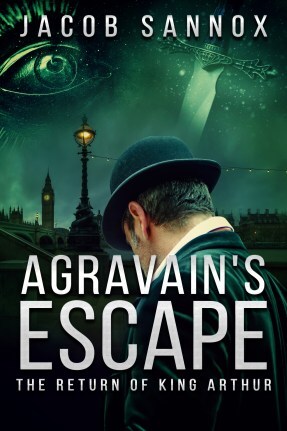 “It has been quite amusing that some readers have actually asked me if Arthur was REALLY involved in this or that, as the rest of the research allowed the scenes to seem credible.” (It did. Obviously, knowing fully well I was reading work of fiction, I was not one of those readers. Probably.) “The point of his return was necessitated by the Ravenmaster of the title. The Ravenmaster is linked to the ravens of the Tower of London. The ravens are, allegedly, linked to Charles II. Charles II was of the House of Stuart, which came under threat during the English Civil War…and the Ravenmaster, as Merlin’s apprentice, wanted his OWN version of Arthur. So I chose a project for him – James VI and I, who was the first king of England, Ireland AND Scotland. Arthur’s legendary role as king of the Britons pales in comparison.”
“It has been quite amusing that some readers have actually asked me if Arthur was REALLY involved in this or that, as the rest of the research allowed the scenes to seem credible.” (It did. Obviously, knowing fully well I was reading work of fiction, I was not one of those readers. Probably.) “The point of his return was necessitated by the Ravenmaster of the title. The Ravenmaster is linked to the ravens of the Tower of London. The ravens are, allegedly, linked to Charles II. Charles II was of the House of Stuart, which came under threat during the English Civil War…and the Ravenmaster, as Merlin’s apprentice, wanted his OWN version of Arthur. So I chose a project for him – James VI and I, who was the first king of England, Ireland AND Scotland. Arthur’s legendary role as king of the Britons pales in comparison.”
The books’ non-linear structure – putting it mildly – means that Sannox gets to kill off some of Arthur’s companions (you have a favourite knight? not anymore!) – but they might come back later, or rather earlier: “A character might die in 2019, but still feature in later books, as they are set partially in the past. And I am sowing plenty of seeds back there, which may bloom later on. For instance, it isn’t too much of a spoiler to say that Agravain gets mentioned once in book one, but his backstory becomes the driving force for the modern plot in book two. Likewise, some who died in book one, are seen in the past in book two. There’s lots of opportunities for examining different characters in different ways at different times.”
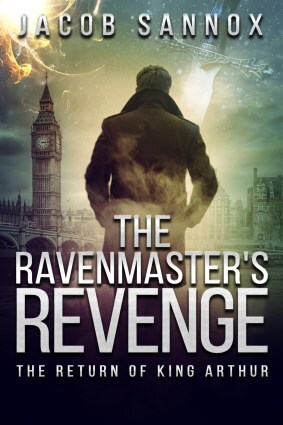 The third installment, Tristan’s Regret, is in the works now. Sannox suggests he’d like The Return of King Arthur to remain a trilogy, but I don’t fall for that. There’s too much creativity, research, and entertainment involved. “I suspect I may write more,” Sannox admits, somewhat reluctantly. “I have…ideas. Gawain could get a leading role, as could Merlin.” Right before I manage to express my excitement, he changes his mind: “I just thought of a new title. The Ravenmaster’s Revenge, Agravain’s Escape, Tristan’s Regret, and then… Bjørn’s Demise.” Hmmm. “How about Bjørn’s Ascent or Fame or Riches?” I helpfully suggest. “This is a Sannox book,” the (onetime) pikeman answers. “Good luck!”
The third installment, Tristan’s Regret, is in the works now. Sannox suggests he’d like The Return of King Arthur to remain a trilogy, but I don’t fall for that. There’s too much creativity, research, and entertainment involved. “I suspect I may write more,” Sannox admits, somewhat reluctantly. “I have…ideas. Gawain could get a leading role, as could Merlin.” Right before I manage to express my excitement, he changes his mind: “I just thought of a new title. The Ravenmaster’s Revenge, Agravain’s Escape, Tristan’s Regret, and then… Bjørn’s Demise.” Hmmm. “How about Bjørn’s Ascent or Fame or Riches?” I helpfully suggest. “This is a Sannox book,” the (onetime) pikeman answers. “Good luck!”
The Ravenmaster’s Revenge can currently be downloaded for free at https://books2read.com/ravenmastersrevenge
The post Interview with Author Jacob Sannox appeared first on BEFOREWEGOBLOG.
March 20, 2022
Review – The 13th Zodiac: Book One by L. Krauch
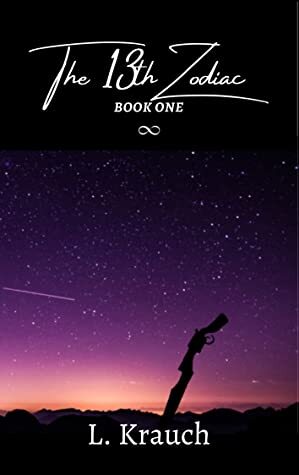 Once, there were four Titans:
Once, there were four Titans:
Urth, the mother of Gaea,
Sky, the father of the heavens,
Fate, the overseer of life and death,
And Time, the keeper of the Eternal Clock.
The lovers, Fate and Time, ruled over all.
Together they kept Gaea at peace,
Until one thousand years ago when
Mother Urth and Father sky created mortal man.
And shattered the Eternal Clock.
Time hated the children of Urth and Sky.
Thus, the Keepers were born.
Time assigned each to small pieces of Gaea,
Taking parts from Fate, Urth, and Sky.
Then, Time turned Urth into the Mother Tree
And dissipated Sky into the clouds.
The Keepers resented Time for what she had done.
For which Time banished them.
What her lover had done disgusted Fate.
To trap Time, Fate turned to the Keeper of the Stars.
Who Time shattered into twelve.
Creating the Zodiac – The heroes of mortal men.
Beneath the boughs of the Mother Tree,
Fate trapped Time for an eternity.
Angry and hurt, Time divided her soul in two.
Thus the 13th Zodiac was born:
Eternity
Time is fickle and petulant. She is the one ephemeral idea of which we simultaneously have too much and never enough. She promises never-ending tomorrows and warps the memories of our yesterdays. Time traps young hearts in decaying bodies and gifts wretched souls with youthful vigor. She tricks us into believing we are more or less than we are, than we could ever be. Time smiles as she gives with one hand and steals with the other.
In The 13th Zodiac, Lacey Krauch delivers her rendition of Time’s saga. Mortals, the children of Urth and Sky, tell their young the tale of Time’s ill-fated quest to repair the Eternal Clock and undo the creation of men. Time is their elusive boogeyman and her lover, Fate, their stalwart champion. But the Titans are distant, little more than fairy tales told as bedtime stories. The Zodiac are all too real. Twelve individuals bearing the sigils as birthmarks, evidence proving the stories are as real as their skin.
When Liya, the daughter of Aria’s Queen and her husband, Prophet Skylis, is born with the eternity symbol on her delicate newborn shoulder, Eternity, the thirteenth zodiac takes her first breath. Skylis, desperate to know the meaning behind his daughter’s mark, convinces Fate to allow him to see Time. Time, still angry over her lover’s betrayal, is trapped in a cave deep under the Mother Tree, held fast by ancient roots. Against Fate’s warnings, he begs Time to show him Liya’s future. Time grants his request, taking his eyes as payment. After all, one doesn’t truly need eyes to see. She kills Fate and is loosed on Gaea once again, determined to repair the Eternal Clock and erase men from existence.
Time chooses Soren, the cruel and grasping King of Chall, as her puppet, enlisting him to search for Liya, the princess of Aria. She gifts his kingdom with superior armaments and encourages his invasion of the tiny island kingdom to expand his borders and take possession of the princess. The now eight-year-old Liya escapes under the protection of sixteen-year-old Jemi, her sworn protector. They make their way to a Brighton, a small coastal village, and are adopted by a friend of Jemi’s father. There they live as commoners. Liya remembers nothing of her life as a princess. Jemi and the adoptive family are vigilant in hiding Liya’s true identity. Until one day, ten years later when a chance encounter with a man in the market. This man turns out to be the Crown Prince of Chall, Jase, Zodiac Leo. Jase has been searching for Liya for years. For reasons of his own, Jase has no intentions of taking the princess back to his monster of a father.
Alarmed by his sudden appearance, Jemi, Zodiac Aries, and her twin adopted brothers, Jiroo and Tokei, Pisces and Capricorn, with the assistance of a local shopkeeper, June, Sagitarrius, kidnap the prince and escape to Undall with Liya. Along the way, Liya’s zodiac-inherited ability to pause time becomes more and more evident. The group has questions and heads to the Keeper’s Library for answers. The librarians are also Zodiacs and happily assist the group on their quest to keep Time from her realizing destructive plans.
Skirmishes with soldiers from Chall, near-misses, breath-taking escapes, heart-breaking betrayals, and mind-boggling revelations stalk the Zodiac across Gaea from the gates of Chall to the Monastery of Fate Divided in the Dark Forest to the prison fortress of Mount Callous. Love is found and lost, families are created and torn apart. Zodiacs are discovered and scattered. Time is killed and a new Titan takes her place.
This book is a page-turner and threatens readers with losing track of Time. Give in to that impulse, just this once. Surely nothing bad will happen if you do.
Check Out The 13th ZodiacThe post Review – The 13th Zodiac: Book One by L. Krauch appeared first on BEFOREWEGOBLOG.



